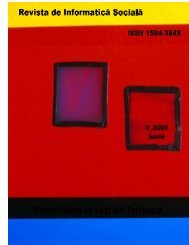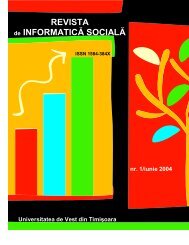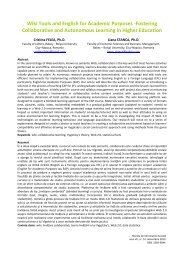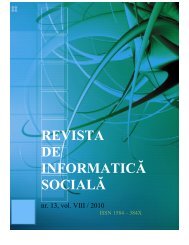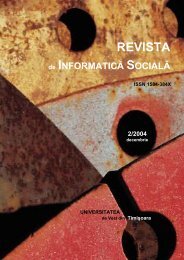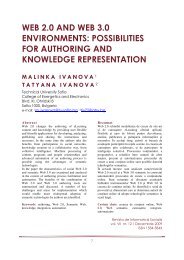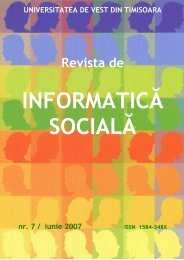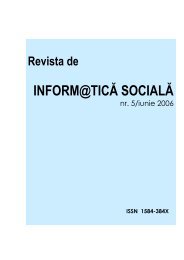Figure 3 - The role <strong>of</strong> WIP in each stage <strong>of</strong> the research-based learningIn the second stage, the teacher <strong>of</strong>fers to the stu<strong>de</strong>nts the opportunity for create their own questions,since related to the theme chosen in the previous stage. While the theme remains in the focus, theteacher, taking into account concerns expressed by stu<strong>de</strong>nts, continues to stimulate their thinking inor<strong>de</strong>r they can be able to <strong>de</strong>ci<strong>de</strong> what will be investigated. The stu<strong>de</strong>nts must to elaborate thequestion – or questions - that induces the investigative activity. In the structure <strong>of</strong> WIP, stu<strong>de</strong>ntswill find potential issues that may help them to gui<strong>de</strong> the research.After the question for the inquiry is ready, in the third stage the teacher will support stu<strong>de</strong>nts in the<strong>de</strong>finition <strong>of</strong> investigative procedures that they intend to adopt, which inclu<strong>de</strong>s choosing the types<strong>of</strong> data that will be consi<strong>de</strong>red for analysis. The stu<strong>de</strong>nts <strong>de</strong>fine the procedures they will use inresearch. The teacher should ensure that procedures are rigorous, consistent with a research methodappropriate to the question to which the answer will be sought in the research. In the structure <strong>of</strong> theWIP some potential procedures can be pointed out, especially including the types <strong>of</strong> data nee<strong>de</strong>d inthe research.Defined the question to which they will look for an answer and set the procedure most appropriated,stu<strong>de</strong>nts begin the search for online data, advancing on the research. In the fourth stage <strong>of</strong> the WIP,the stu<strong>de</strong>nts' ability to perform advanced searches on the Internet - using search engines like Googleand Bing - will be essential. At that moment the teacher must to assist stu<strong>de</strong>nts in seeking data ononline sources, being essential to ensure their credibility. It is absolutely essential that the sourcesare reliable. The teacher can participate with stu<strong>de</strong>nts in the pursuit <strong>of</strong> data sources. The WIPproposal does not eliminate, however, the possibility <strong>of</strong> the teacher <strong>of</strong>fer to the stu<strong>de</strong>nts some preselectedsources as examples. In this stage, the WIP <strong>of</strong>fers a list <strong>of</strong> potential sources <strong>of</strong> online data.The fifth stage is the time for stu<strong>de</strong>nts manipulate and analyze the data collected on the Internet.The teacher must ensure that stu<strong>de</strong>nts are able to use the tools necessary to analyze data that theycollect online. If numerical data are used, may be necessary for stu<strong>de</strong>nts to be able for using aspreadsheet or statistical s<strong>of</strong>tware. If stu<strong>de</strong>nts are <strong>de</strong>aling with data that are not numeric, s<strong>of</strong>twarefor generating a conceptual map or for database management may be appropriated. If necessary, theteacher will ensure that there is a previous training <strong>of</strong> stu<strong>de</strong>nts for appropriate use <strong>of</strong> the s<strong>of</strong>twarethey choose as more appropriated. In the fifth stage, the structure <strong>of</strong> the WIP can <strong>of</strong>fer someexamples <strong>of</strong> handled data.The next task <strong>of</strong> the stu<strong>de</strong>nts is to draw their own conclusion in the investigation. And as theinvestigation has no meaning if the conclusion is not a<strong>de</strong>quately communicated, in the sixth stagethe stu<strong>de</strong>nts will report their findings, being essential that the conclusion they reach is properlysupported in the data they collected. The results will be presented in various forms: text, graphics
and even orally. The teacher will assist stu<strong>de</strong>nts in choosing the most appropriated form to presentthe results <strong>of</strong> the research, ensuring they have the necessary skills in or<strong>de</strong>r to use appropriately thes<strong>of</strong>tware to produce the research report. It is possible that at this stage stu<strong>de</strong>nts may be <strong>de</strong>fining newresearch questions that will justify new inquiry, restarting all the process. WIP provi<strong>de</strong>s examples <strong>of</strong>results and can also provi<strong>de</strong> sample questions for further investigation.The WIP, as a learning proposal, brings the possibility that at the second stage, instead <strong>of</strong> stu<strong>de</strong>nts,the teacher <strong>de</strong>fine the question that will gui<strong>de</strong> the research. In this case, stu<strong>de</strong>nts would continuewith the research, making more appropriate methodological choices and leading the rest <strong>of</strong> theinvestigative process. In the event that the teacher formulates the question that will lead theresearch, we have what we call WP Type I. When since the formulation <strong>of</strong> the question that leadsthe inquiry all the process is a task for the stu<strong>de</strong>nts and <strong>de</strong>pends <strong>of</strong> their choices, we have what wecall WIP Type II.If we compare the procedures for WIP with levels <strong>of</strong> research <strong>de</strong>fined by Herron (1971), the WIPtype I exemplifies the gui<strong>de</strong>d research, since the question that gui<strong>de</strong>s the research is <strong>de</strong>fined by theteacher, whereas type II corresponds essentially to the open investigation (Table 3).Level Type Activity0 Confirmation/Verification -1 Structured Inquiry WebQuest2 Gui<strong>de</strong>d Inquiry WIP type I3 Open inquiry WIP type IITable 3. WIP, WebQuest and levels <strong>of</strong> researchThe WIP, in any <strong>of</strong> its forms, presents a much lower level <strong>of</strong> structure than the WQ. That is whyWIP allows greater autonomy for the stu<strong>de</strong>nts (Figure 4). Of course, the exercise <strong>of</strong> autonomy willrequire the stu<strong>de</strong>nts more responsibility for the learning activity to become effective and in or<strong>de</strong>r toassure the <strong>de</strong>velopment <strong>of</strong> required skills.Figure 4 - WebQuest, WIP, levels <strong>of</strong> structure and autonomy
- Page 1: Revista de Informatica Sociala 14 /
- Page 7: ● ● ●CONTENTS● ● ●[9-20
- Page 10 and 11: THE TRANSITION FROM OLD TO NEW MEDI
- Page 12 and 13: 30252023.420.325.11510500.85.5Never
- Page 14 and 15: Overall, we can therefore sum up on
- Page 16 and 17: n.a.I often use itI seldom use it6.
- Page 18 and 19: - Traditional web use: searching th
- Page 20 and 21: 19. Kvavik R.B., Caruso J.B. and Mo
- Page 22: IntroductionIn 1995, Bernie Dodge o
- Page 25: The Web-Inquiry Project [WIP] is a
- Page 29 and 30: environment in which the teacher gu
- Page 31 and 32: Transformation Through Online Learn
- Page 33 and 34: INTRODUCTIONLeading practitioners a
- Page 35 and 36: learning. We also describe how the
- Page 37 and 38: Some of these transformations are b
- Page 39 and 40: Recently, Twigg has received suppor
- Page 41 and 42: Stage III: Unbundled Learning, Mark
- Page 43 and 44: perhaps using Second Life-like virt
- Page 45 and 46: performance. Indeed, Stage V will l
- Page 47 and 48: Free-Range Open LearningOver time,
- Page 49 and 50: New communities, tools and services
- Page 51 and 52: Embed enterprise-wide predictive an
- Page 53 and 54: In collaboration with Strategic Ini
- Page 55 and 56: Wiki Tools and English for Academic
- Page 57 and 58: eality. Besides being an additional
- Page 59 and 60: StudentPage 1StudentPage nTeacher
- Page 61 and 62: 100%90%80%70%60%50%40%30%20%10%0%Ac
- Page 63 and 64: 200Correlation View/Page Edits150Vi
- Page 65 and 66: 14. http://eacea.ec.europa.eu/llp/s
- Page 67 and 68: Simularea şi comunicarea electroni
- Page 69 and 70: RespondenţiRăspunsuriLa nivelul
- Page 71 and 72: RespondenţiRăspunsuriLa nivelul
- Page 73 and 74: Respondenţii au fost rugaţi să i
- Page 75 and 76: Itemul 9 doreşte să identifice ti
- Page 77 and 78:
Identificara opţiunii, chiar şi p
- Page 79 and 80:
EşantioaneRăspunsuri/Ranguriagita
- Page 81 and 82:
modalităţile practice prin care u
- Page 83 and 84:
1. INTRODUCEREÎn prezent, complexi
- Page 85 and 86:
Figura 1. Analiza grafică a evolu
- Page 87 and 88:
Faţă de această situaţie se deg
- Page 89 and 90:
variabilele acesti noi culturi cybe
- Page 91 and 92:
INTRODUCEREÎncă din anul 2000 am
- Page 93 and 94:
după tipul lecţiei: prezentare de
- Page 95 and 96:
Funcţiile oferite de AEL asigură
- Page 97 and 98:
• elevi/studenţi, beneficiari di
- Page 99 and 100:
Se poate folosi cadrul formal de co
- Page 102 and 103:
Evaluarea formativă este comentari
- Page 104 and 105:
Rezultatele elevilor, pe itemi:Diag
- Page 106 and 107:
Nr. Denumirea activităţii AEL MOO
- Page 108 and 109:
SEMNAL EDITORIALLaura MALITA, Vanna
- Page 110:
IN MEMORIAMConstantin TraianCHEVERE



